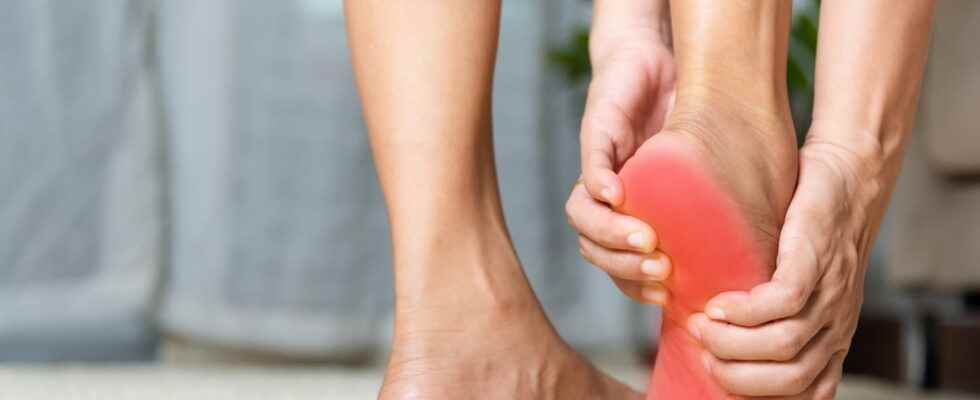Pain under the foot? Athletes, especially joggers, often have pain located in the heel or the arch of the foot: this is theplantar fasciitis, plantar fasciitis or theplantar aponeuropathy. But it’s not just them. Anyone can be prone to this heel condition. Ultrasound or MRI can diagnose plantar fasciitis. What are the symptoms of an aponeurosis? How to walk with plantar aponeurosis? With some soles adapted? What treatments to heal? How much healing time ?
“plantar aponeuropathy is not inflammation because there are no inflammatory cells. It’s more about micro-trauma effort-related (in the event of abnormal or repeated traction on the plantar aponeurosis)”, describes Dr. Douglas Levy Biau, sports doctor. a common condition in activities requiring pulses or jumps. It causes heel pain, which usually occurs after getting up.
What causes plantar fasciitis?
The main cause remains foot abnormality. Among the contributing factors:
- Significant sporting solicitation (long walks, races, etc.)
- Running on too hard ground
- To have some unsuitable shoes
- Running with poor technique, downhill or on the forefoot
- A postural disorder or an architectural disorder of the rear foot (flat foot, hollow, valgus, pronation, varus)
- Handling heavy objects
What are the symptoms of plantar fasciitis?
Plantar fasciitis causes heel pain, which is called heel pain. They most often appear immediately after getting up, worse on bearing or walking. The pains can prevent the support, obliging the patient to walk on the front of the foot or the external edge of the foot. They can become chronic if no treatment is started during the 6 months after the appearance of the first pains.
What tests to diagnose plantar aponeurosis?
A heel x-ray may reveal a thickening of the soft tissues located at the level of the heel as well as micro-calcifications. Above all, this examination makes it possible to rule out the presence of a tumor or a fracture. It’s’ultrasound which highlights a thickening of the aponeurosis. A MRI can allow a more precise diagnosis, in particular at the level of the localization in case of doubt and makes it possible to pose a differential diagnosis.
What are the complications of plantar fasciitis?
In the absence of treatment, the support at the level of the heel is more and more painful, there is a risk of:
- Lamenesslack of support, difficulty fitting
- Training of fibrous nodulesx
- Rupture of fascia
What are the treatments for plantar aponeurosis?
► Wearing suitable shoes: it is advisable to wear more shock-absorbing shoes, with a light heel to reduce the pain of the beginning of the aponeurosis.
► Medications : analgesics or anti-inflammatories can be prescribed by the doctor, they help relieve pain and reduce acute inflammation.
► Ice application several times a day to relieve pain. Several techniques are possible, such as placing the feet in water containing ice cubes, rolling a bottle of ice water for 5 minutes under the soles of the feet, massaging the foot with ice cubes or placing it on an ice pack.
► Rehabilitation physiotherapy: “Physiotherapy allows, through stretching exercises, to reduce the intensity of pain. By using shock waves, the physiotherapist can relieve 75% of pain“, describes Dr. Douglas Levy Biau. Deep transverse massages can also be performed.
► Steroid injections : carried out under ultrasound, they can be considered as a last resort if the treatments do not work. A treatment by injection of PRP (Platelet Rich Plasma) can also be performed.
► Sometimes: the use of shock waves or at mesotherapy can be offered.
When to consider an operation in case of plantar aponeurosis?
If the medical treatment is insufficient, surgery can be proposed: it consists of the partial or total section of the plantar aponeurosis. The healing of the fascia then occurs spontaneously in a few weeks, in a relaxed position, causing the pressure on the bone insertions to drop, in particular on the calcaneal insertion. The intervention lasts between 30 and 45 minutes. The operation is usually done on an outpatient basis, but it can sometimes require a night of hospitalization if there is a health problem. Operative anesthesia may be locoregional (anesthesia encompassing a segment of a limb, from the leg to the toes), spinal (anesthesia of the pelvis and limbs by pricking between two vertebrae) or general anesthesia.
When to wear insoles?
Wearing plantar orthoses (more commonly called orthopedic insoles) makes it possible to correct architectural disorders of the foot and relieve inflammation. Do not hesitate to consult a podiatrist.
Can we do sport in case of aponeurosis?
Yes, we can for example continue to walk. Buthe treatment of plantar aponeurosis goes hand in hand with stopping impulse sports or weight bearing, such as running and jogging. 3 to 6 months, even 1 year are necessary for the pain to disappear. During this time, it is advisable to favor sports that do not cause pain, such as swimming or cycling, provided they are practiced without forcing too much.
What prevention tips to avoid aponeurosis?
In order to avoid the appearance of plantar aponeurosis, it is advisable to choose shoes that are well suited to your foot and change them as soon as they are worn out. Do not forget to practice stretching exercises and to massage your feet regularly, with a small bottle filled with ice water for example.
Thanks to Dr. Douglas Levy Biau, sports doctor.
